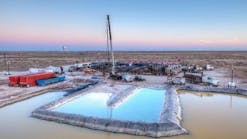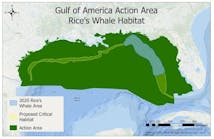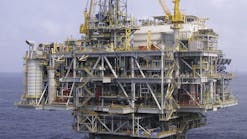Jerry W. Box
Oryx Energy Co.
Dallas
As one of the largest independent oil and gas companies in the world, Oryx Energy Co. has become a strong international player. In an increasingly global business, we are competing with some very tough international companies.
This competition calls for our continued focus on technology and innovative ways of conducting our business, not only on the international scene but also in the U.S. Here I will focus on ways our company is approaching U.S. activities, both onshore and in the Gulf of Mexico.
ONSHORE U.S.
In the onshore U.S., Oryx Energy has mature assets. We have a seasoned workforce. However, our upside exploratory potential is somewhat limited.
Some time ago, Oryx Energy's onshore managers concluded that we were managing, multitude, not magnitude. "We held a tremendous number of assets, some large and very promising, some quite small and economically marginal.
With this broad spectrum of assets of widely variant size, we could not use our time, human energy, and money to maximum efficiency.
Management identified this opportunity and the corresponding need to always strive for improved focus, flexibility, and ability to pursue our objectives objectively as reasons to change.
We have changed the organization and the way we work among ourselves, and we have changed the way we work with our suppliers of services and equipment.
Most of the organizational changes took effect Oct. 1. They were shaped partly by changes already in effect in our relationships with suppliers and partly by our recognition that former practices simply would not do the job in the 1990s.
Ours is not the only effort of its type in the oil business and may not be the most profound. To Oryx Energy managers and employees, it nonetheless means an overhaul of attitudes, habits, and ways of thinking about problems and projects.
This article will describe how we studied our company, what changes we prescribed in response to the challenges we identified, and why we decided to proceed as we have.
NEW ONSHORE ORGANIZATION
We began with a study, of Oryx's onshore operations. Our organization was traditionally functional, with exploration and production units, operational units, drilling units, and so forth. Against the challenge of managing many assets of widely varying size, the functional approach seemed cumbersome and worthy of review.
So we formed a team to study our onshore business processes. We asked the team to consider team concepts, to examine ways to do away with functional barriers, to see how we might focus the expertise of our workforce on key assets, and to identify ways to make best use of technology.
The team included engineers, geologists, and land people, not all of them from onshore operations. The team leader had just been moved to the U.S. from the U.K. North Sea.
Our aim was to take a fresh look at our onshore U.S. activities to see how we could manage our assets better. Out of this study grew the onshore reorganization that we announced Oct. 1.
We now have four groups that we call enterprise units to manage onshore assets in discrete geographic areas (Fig. 1). Each group has three interdisciplinary teams that, like the enterprise units, are organized geographically.
The teams are essentially self-managed. Each has expenditure authority, goals, and accountability.
The teams are multifunctional as well. Each has the engineers, geologists, geophysicists, and other professionals needed to get the job done in its area of responsibility.
We selected professionals for this new organization on the basis not only of their technical competence but also of their abilities to work as members of teams. They have to be willing to share resources. Team leaders, too, will be sharers, not traditional command-and-control managers.
By avoiding the breakdowns that may encumber functionally organized companies, we expect to be able to create maximum value from our assets.
NEW RELATIONSHIPS
Reorganization isn't the only adjustment we have made in this effort to revitalize our onshore assets. We are also streamlining our operations through alliances with suppliers. Arrangements like this could become an important part of the oil and gas business.
So far, we have formed three alliances with service companies. Our reason for doing so is always the same: Someone else can fill a need for us better than we can.
The need can be anything, such as technology, manpower, or investment. The need may relate simply to time. For example, we might form an alliance with someone who can complete a project that we simply could not get to on our own in time to meet a deadline.
The key to making alliances successful is ensuring that both parties benefit.
In two of our alliances, the service companies have work contracts covering many wells: more than 40 in one case, 20 in another. The contracts run for as long as is required to complete the work.
The long tenure and multiple-well nature of the contracts enable the service company to plan its work and to know what it is going to do over a significant period.
Oryx Energy benefits because the agreements are based on productivity: Our alliance partners agree to perform faster and with greater volumes than we could achieve negotiating the work well by well. For us, this means more profit.
We expect alliances such as these to be increasingly common in the industry. Essentially, they place the operator and the contractor on the same side of the table in pursuit of common goals: lower costs and greater volumes.
Historically, we have spent much time bidding, and contractors have spent much time selling. With alliances we save time and accomplish things that we otherwise could not.
Oryx Energy will likely enter further alliances. Until our reorganization, alliances were formed at various levels of the company. Now they will be negotiated at the team level.
TAKING A NEW LOOK
In addition to working increasingly through alliances, our teams are taking fresh looks at the assets they manage. This is an important way of targeting optimum returns.
Using 3D seismic technology as a principal tool, we have begun seismic surveys over our major fields. We expect the result to be new drilling targets, both development and exploration opportunities, neither of which were likely to be identified without this initiative.
We have used this strategy effectively offshore. The increasing cost-effectiveness of 3D seismic technology enables us to adapt the strategy to our onshore operations.
We have already completed seismic work in some areas and begun drilling on prospects that emerged.
For example, in 1991 we acquired 56 sq miles of seismic data over the Belle Isle field in St. Mary Parish, La. This field, discovered in 1941, has produced more than 1 tcf of natural gas from 54 reservoirs.
With new information based on 3D seismic interpretation, reservoir engineering data, and well control, the new mapping indicated several untested deep fault blocks and many additional opportunities in the shallower Miocene sands that weren't apparent with 2D seismic data (see Fig. 2).
The mapping pointed to new drilling opportunities and workovers on existing wells. The BIN-VUA No. 5-6, drilled to 17,300 ft with the objective being Miocene Rob 43-2 sands, found 49 ft of net pay sand and is currently producing at a rate of 20 MMcfd of gas at a flowing tubing pressure of 5,875 psi (Fig. 3).
OFFSHORE U.S. CHANGES
Offshore, we are looking at projects differently from how we viewed them before.
In the past, we operated sequentially; that is, we worked through a series of steps to reach a platform decision. Now, in a process we call fast-tracking, we work on many things at the same time, handling them in parallel rather in sequence.
The objective is value creation. We want to minimize the amount of time between discovery and production.
Fast-tracking has the potential to create value, but it also poses challenges of its own, including the possibility of incurring some expenditures on projects that might not move forward.
The value added by bringing on projects early, however, is expected to far exceed any value that might be lost as a result of fast-tracking.
Last July, we began production on Mississippi Canyon Block 400 in the Gulf of Mexico, having made the decision to produce the block the preceding October. Under the old, sequential method, 2 years might have elapsed between the decision to produce and the first production.
At the same time, we had to make sure that we had internal alliances and teamwork in place. For example, our gas marketing organization identified the need for increased capacity off the platform and put into place a series of swing, spot, term, and long-term contracts coupled with transportation.
This assured the gas would flow in the early phases and ultimately will reach a premium local distribution company market under firm transportation once resources and production have stabilized.
Fast-tracking cut the time by more than one-half. We completed the three producing wells subsea and tied them back to a platform on the shelf. The three wells are now producing more than 40 MMcfd. We'll use information from these wells to guide our decisions about subsequent drilling.
The later drilling illustrates another new way of thinking about offshore work: staging development. On Mississippi Canyon Block 400 we started production, and quick cash flow was our objective. But we know we'll have other development opportunities there. By not waiting to produce all our reserves at once, we began recovering capital much more quickly and thus raised the value of our asset.
Another staging concept, which we are considering for other areas, is to envision complex areas as stacks of risk and to work through the risks one layer at a time, beginning with the lowest.
Development of a deepwater discovery with a major platform might be uneconomic, for example, because the reserves are spread over a wide area or due to a technological problem.
We might, however, set a miniplatform and drill in the heart of the area, where our risks are lowest, to get production started. That way we get volumes without having committed ourselves to risky, full-scale development. If it works, we can examine ways to develop the rest, working in stages, with each stage optional.
OFFSHORE TECHNOLOGY
Much of the new way of thinking about the offshore oil and gas business grows out of application of advanced technology.
One part of this trend might be called "finder technology," essentially in the area of geophysics.
The offshore, better than the onshore U.S., lends itself to geophysical applications. Techniques such as direct hydrocarbon indicators, amplitude vs. offset interpretation, and prestack depth migration have significantly lowered risks offshore.
Furthermore, the techniques have enabled us to identify drilling targets beneath salt, something we could not do until very recently. Salt occurs over a large area of the Gulf of Mexico. By creating the ability to image subsalt structures, technology has, in effect, given us the areal equivalent of a new country to map and explore.
Finder technologies have not only opened new areas for exploration but also reduced risks in mature regions.
Direct hydrocarbon indicators have been especially helpful.
In the past 5 years, Oryx Energy's success ratio offshore has improved from one in five to about two in three, largely as a result of hydrocarbon indicators and 3D seismic.
Another area of rapid improvement is production facilities technology.
The ability to produce through facilities like miniplatforms and subsea completions gives us the flexibility we need to apply new concepts such as development staging and fast-tracking. As a result, oil and gas deposits that would have been noncommercial under traditional practices can find ways to reach a production platform and become commercial.
CONCLUSIONS
Volatile oil and gas prices toughen our economic challenge. Technology, however, helps us to make economics work for us rather than against us, to examine our assets in new ways in order to realize maximum value from them.
Success, therefore, will come to the smart, the efficient, and the flexible. It will create new relationships among professionals, among industry partners, and among buyers and sellers of oil field equipment and supplies.
Copyright 1993 Oil & Gas Journal. All Rights Reserved.


